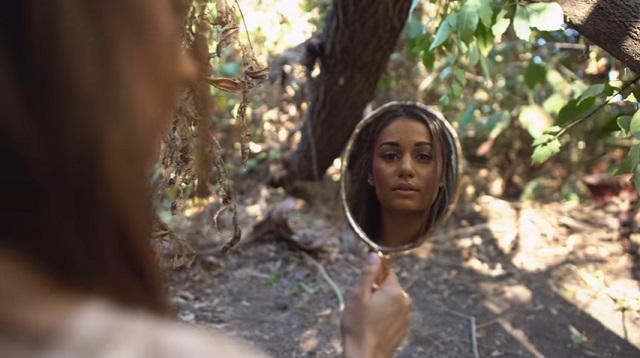
“Forgiveness is not always easy. At times, it feels more painful than the wound we suffered. And yet, there is no peace without forgiveness.” ~ Marianne Williamson
My client Tammy was making terrific progress with her food issues but was still seized with anxiety whenever she had lunch with her girlfriends.
While the ladies blithely ordered their fare, Tammy obsessed over the menu, pitting what she wanted against what she “should” have.
When we looked into the roots of this struggle, Tammy saw herself as a teenage mom, watching her girlfriends having fun while she was swamped with a low-functioning husband and two young daughters.
At her high school graduation, Tammy glumly looked on while her classmates received awards and tossed their caps in the air.
With my guidance, Tammy journeyed back to soothe and reassure her younger self, then re-envisioned the graduation experience so that her younger self was included in the celebration, receiving a standing ovation for blessing the planet with two beautiful children.
Self-forgiveness flooded through Tammy as she imagined this new scenario.
Weeks later she excitedly reported, “I eat whatever I want now. And by the way, I’ve lost 15 pounds!”
What Does It Take to Forgive?
As women, we’re conditioned to be peacemakers. We pressure ourselves to forgive quickly in the interest of being nice.
But true forgiveness is much more than a quick “I’m sorry.” True forgiveness is a journey of the soul.
While there are no right or wrong ways to go about this task, there are some common ingredients to the forgiveness recipe:
1. Start where you are. Just as Tammy had to feel fully her shame and hopelessness before she could let them go, likewise we must touch and love those shadow parts of ourselves that keep us stuck in our pain, for they contain the keys to our healing. Forgiveness comes in its own time and will most likely come sooner if you accept yourself where you are.
2. Don’t try to figure out forgiveness. Forgiveness is a spiritual process that doesn’t answer to logic. When we make a genuine decision to forgive, our inner and outer worlds shape-shift around our intention. We must set our thinking aside to allow the path to unfold.
3. Allow another to witness your pain. However wise we are spiritually, we cannot heal our pain without support from others. Even though Tammy knew the origins of her struggles with food, she couldn’t liberate herself on her own.
When you are ready, disclose your wounds to someone you can trust. Ideally, this person has overcome their own ordeals and can provide guidance, tools, and emotional support that will catapult your forgiveness forward.
4. Let it all out. Don’t try to be spiritually hygienic while unpacking your pain. The more rage, pettiness, and nastiness you can disgorge, the faster the healing.
5. Know that forgiveness takes many forms. You might forgive someone and never want to talk to him again. You might need to set new terms for the relationship. It’s okay to set whatever boundaries you need for your healing. True forgiveness is the purview of the brave. It doesn’t always look nice.
Which Practices Support Forgiveness?
While every spiritual tradition has its forgiveness practices, here are a few that I find helpful. You can do any one of these or all three in succession.
You can do these alone or with a witness. If you do them alone, I suggest you “bookend” them with someone. Call her beforehand and describe what you intend to do, then call her again after to recount the experience.
1. The resentment buster.
This is a powerful practice if rage, righteous anger, and other strong emotions hamper your ability to forgive.
Write a letter to the person you’re trying to forgive, whether yourself or someone else, venting all your grievances and negativity. This letter is for your eyes only.
When you feel complete, imagine yourself as that person returning a letter to you. Allow them to express all their raw emotions and judgments about you.
Continue writing back and forth until the negativity is exhausted on both sides.
Then write a letter of appreciation to that person. Express your gratitude, your love, and your goodwill. Write a letter from that person back to you expressing those same feelings.
Burn the letters after the process is complete.
2. The decision ritual.
You’ll need a mirror, a candle, and a journal. You’ll also need a private space free from interruption.
Plan to spend at least 30 minutes performing this ritual.
Light your candle.
Begin by sitting in meditation with your eyes closed and your hands on your heart, connecting to your heartbeat. If your attention wanders, bring it back to that beating heart. Sit this way until you feel more settled in your awareness.
Think about who you want to forgive, whether it be yourself or someone else. Spend a few minutes journaling about why you want to forgive this person. If it feels hard to forgive, write about that.
When your writing is complete, look at yourself in the mirror. Say aloud, “[Name], I now forgive you.”
Repeat this out loud until you feel complete. Spend a few moments being present to the thoughts and feelings that arise. Write them down if necessary.
3. The 14-day prayer.
Every day, for 14 days, pray for the person you’d like to forgive.
Begin by reflecting on what you seek to gain from forgiving that person (peace, joy, freedom). Arouse those feelings in your heart, then mentally give those feelings away to the other person, saying, “[Name], may you be peaceful. May you be joyful. May you be free.”
If the object of your forgiveness is still alive, don’t be surprised if something in the relationship profoundly shifts as a result of these practices. That person might write an actual letter to you, or offer a heartfelt apology, or just start being a kinder person.
If you hold the view that, on the quantum level, we are all truly one, then likewise, you must the hold space for the potential impact your act of forgiveness can have on others.
Please post a comment below and share your experiences with this ritual. And please stay tuned for next month’s post, which will describe the benefits of forgiveness.
~
~
~
Author: Marcella Friel
Image: Youtube
Editor: Lieselle Davidson








Read 0 comments and reply